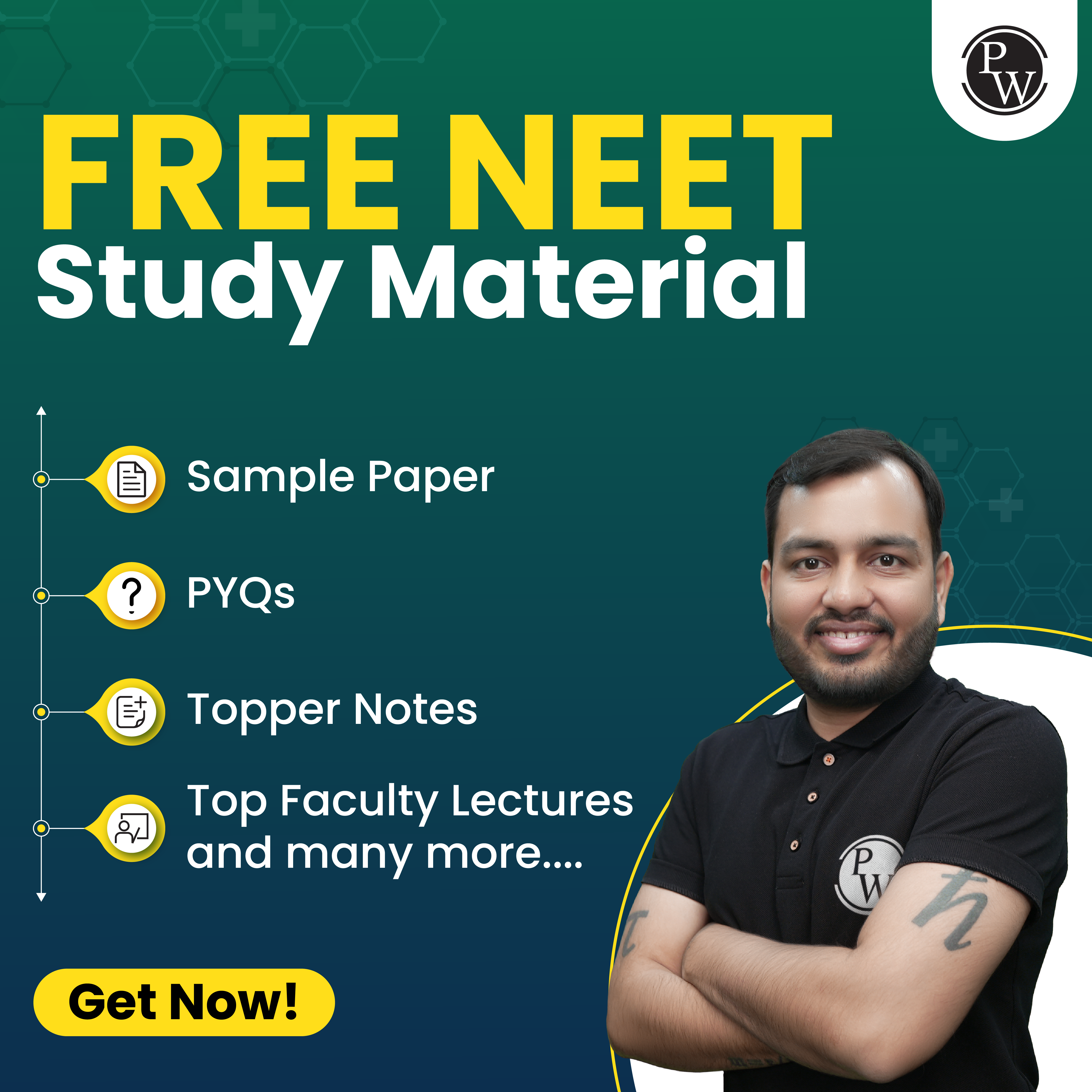
Biotechnology MCQ for NEET Introduction
Biotechnology MCQ: The vast field of biotechnology involves using biological processes, animals, cells, or cellular components to create new technologies. Biotechnologists create innovative equipment and products that are helpful in research, agriculture, business, and medicine.
In the past, biotechnology was only used to produce bread, alcoholic drinks, and crossbred livestock and agricultural products. The use of biotechnology for the benefit and well-being of humanity has increased thanks to the effective utilization of modern scientific advances like genetic engineering and recombinant DNA technologies.NEET Study Material, Free Sample Papers, Book, Toppers Notes, PYQs
Biotechnology and its application have a good weightage in the Biology NEET exams and a lot of questions are asked about this diverse topic. In this article, we will discuss some probable multiple-choice questions from Biotechnology and its related topics.Biotechnology Mcqs For NEET Biology
Q 1. Before examining the biological basis of the hereditary human illness sickle-cell anemia, a researcher first isolates DNA from an affected person's cells. The subsequent step involves using
- Restriction enzymes, which fragment DNA into smaller pieces at known places.
- Gel electrophoresis, which isolates the DNA from other cell fragments.
- DNA ligases that help DNA bind to one another
- DNA polymerase, which creates new copies of DNA.
Answer- Option (a) is correct.
Explanation: Once a DNA fragment has been isolated from a patient, it must be first broken down into small pieces which are then subjected to gel electrophoresis for separation. Without cutting the fragments, the DNA bands cannot be obtained. DNA polymerase is used in the process of replication of the DNA and ligases are used to join DNA fragments not for identification.
| NEET Exam Important Links | |
|---|---|
| NEET Syllabus | NEET Biology Notes |
| NEET Eligibility Criteria | NEET Exam Pattern |
| NEET Previous Year Question Papers | NEET Biology Syllabus |
Q 2. The usage of agarose derived from seaweeds is
- Spectrophotometry
- Gel electrophoresis
- PCR
- Tissue culture
Answer- Option (b) is correct.
Explanation: The process of Gel electrophoresis requires a transparent medium that can be used to observe the negatively charged DNA fragments as they migrate toward the opposite charge. For this purpose agarose gel is essential. The remaining processes do not utilize agarose in any step.
Q 3. Plants resistant to _____ have been created with the application of RNA interference.
- Pests
- Yeast
- Nematodes
- Viruses
Answer- Option(c) is correct.
Explanation: The process of RNA interference can be used to inactivate specific genes in the nematodes which are essential for their growth and reproduction. This protects the plants from nematode infestation. Other genetic engineering techniques are utilized for pests, yeasts, and viruses.
Q 4. A successful polymerase chain reaction cannot be carried out without which of the following?
- All four DNA bases
- DNA Polymerase
- Both A and B
- Only A
Answer- Option(c) is correct.
Explanation: In Polymerase chain reaction, a single target DNA strand is copied multiple times. For this replication, DNA polymerase is the main enzyme and all four DNA bases need to be added to the newly forming DNA strands.
Q 5. Read statements (1-4) through to the end.
(1) Rosie, the first transgenic buffalo, produced milk enhanced with human alpha lactal albumin. (2) Restriction enzymes are employed in the separation of DNA from other macromolecules. (3) One stage of R-DNA technology is downstream processing. (4) To introduce R-DNA into the host, disarmed pathogen vectors are also utilized.Which two statements stated above are correct?
- Statements 2 and 4
- Statements 3 and 4
- Statements 1 and 3
- Statements 2 and 3
Answer- Option (b) is correct.
Explanation: The statement 3 is correct because downstream processing is used in a polymerase chain reaction to produce recombinant DNA. Statement 4 is also correct because pathogen vectors can integrate the desired DNA and transfer it into the host cell if they are disarmed. Statement 1 is incorrect because Rosie was not a buffalo but a cow and statement 2 is incorrect because Restriction enzymes can slice DNA into fragments but cannot separate them from other biomolecules.
Also Check:
Q 6. Which kind of rice was patented by a U.S. company, despite the fact that the majority of variants of this rice are found in India?
- Co-667
- Sharbati Sonora
- Lerma Roja
- Basmati
Answer- Option(d) is correct.
Explanation: The patent for basmati rice was granted to an American company by the U.S. Patent and Trademark Organization. The remaining variants of rice are patented by Indian companies.
Q 7. Why is it that species as different as bacteria and humans can have their DNA analyzed using the same fundamental methods?
- Every cell in every creature is identical.
- Every organism has the same quantity of DNA.
- All creatures have the same DNA sequence.
- All organisms have the same DNA structure.
Answer- Option(d) is correct.
Explanation: The structure of the DNA is highly preserved in all organisms which allows the scientists to analyze the DNA using the same fundamental methods. All cells in the body are not identical, and the sequence and quantity of DNA can vary from organism to organism.

Q 8. The cultivation of Bt cotton has received a great deal of interest. What does "Bt" stand for?
- Cotton seeds with barium added
- Possessing a gene for a Bacillus thuringiensis endotoxin
- Biotechnology-based production
- Cotton thread in a larger size with increased tensile strength
Answer- Option(b) is correct.
Explanation: The endotoxin from Bacillus thuringiensis is responsible for the insecticidal activity which makes the BT cotton special. Barium is harmful to the plant and is not used with the seeds. BT stands for Bacillus thuringiensis and not biotechnology.
Q 9. What is the process for introducing recombinant DNA into a host cell?
- Growing the host cell in an ampicillin-containing growth media.
- Covering the DNA with carbohydrates to encourage cell engulfment of the DNA.
- Stimulating cells with electrical pulses or calcium ions to make them more permeable.
- Administering proteins to host cells to increase their permeability.
Answer- Option(c) is correct.
Explanation: Calcium ions interact with the cell membrane of the host cell similar to electric currents and make them competent to take up the foreign DNA. Carbohydrates or proteins cannot increase cell competency because they cannot cross the membrane barrier.
Also Check:
Q 10. What is an illustrat ion of gene therapy?
- The manufacture of the injectable hepatitis B vaccine
- The development of vaccinations for edible crops like potatoes
- The insertion of the adenosine deaminase gene in SCID patients
- Creating children in test tubes by artificial insemination and implantation of fertilized eggs.
Answer- The correct option is (c).
Explanation: Gene therapy is the use of biotechnology to change or alter certain genes to treat diseases. The insertion of the adenosine deaminase gene in SCID patients is one such technique that reactivates the immune system and improves the disease-fighting capacity of the patient.
Q 11. What enzyme is responsible for the removal of nucleotides from DNA's ends?
- Endonuclease
- Exonuclease
- DNA ligase
- Hind II
Answer- The correct option is (b).
Explanation: Exonucleases are DNA-cutting enzymes that remove nucleotides from the endpoints. Endonucleases cut the DNA in the center. DNA ligase is used to join DNA molecules and Hind II is a vector for DNA transfer.
Q 12. Which of the following component(s) does biotechnology include?
(1) the creation of a gene (2) in vitro fertilization (3) fixing a gene that is incorrect; (4) creating a DNA vaccine;- (1) and (2);
- (2) and (3);
- (3) and (4);
- (1), (2), (3), and (4).
Answer- The correct option is (d).
Explanation: All the following components are a part of biotechnology and its applications. Genes can be created using r-DNA
technology, in vitro fertilization and DNA vaccine creation require genetic engineering and gene therapy can be used to fix an incorrect gene.Q 13. Select the appropriate statement(s).
(1) IARI has created a vitamin C-rich mustard cultivar. (2) The Pusa Sawani cultivar of Okra is aphid-resistant. (3) The hairiness of the leaves improves insect pest resistance. (4) Agriculture employs over 62% of the Indian population and accounts for around 33% of India's GDP.- (1) and (2)
- (2) and (3)
- (1), (3), and (4)
- None of these are correct.
Answer- The correct option is (c).
Explanation: Statements 1,3 and 4 are correct. Pusa Sawani is a cultivar variety of Okra but it is not resistant to aphids but rather to fruit borer and shoot. A mustard cultivar has been genetically engineered by the Indian Agriculture Research Institute which stores more vitamin C, hairy leaves prevent insects from eating the leaves and agriculture is the major contributor to the development in India.
Q 14. Which among the following is a commercial product made from genetically altered bacteria?
- Thyroxine
- Human insulin
- Testosterone
- Penicillin
Answer- The correct option is (b).
Explanation: By inserting the genetically altered human insulin gene in bacteria, it is possible to produce millions of copy of insulin which prevent the need to extract it from animals. Penicillin is commercially produced by culturing bacteria, and thyroxine, and testosterone are obtained from animals.
Q 15. Which animals are transgenic?
- Animals with foreign DNA in some cells
- Animals with foreign DNA in all cells
- Animals with foreign RNA in all cells
- Both (a) and (c)
Answer- The correct option is (b).
Explanation: In order to produce transgenic genetic alteration is introduced in the ovum or fetus level or the entire DNA of all the cells changes rather than affecting DNA in some cells. RNA alteration does not produce transgenic animals.
Elevate your NEET preparation with Physics Wallah NEET online coaching . Our experience with experienced faculties guides the students through interactive classes and comprehensive study materials. Join us for personalized learning, covering the NEET syllabus thoroughly, and boosting your confidence to excel in the medical entrance exam.Check More Important NEET Biology MCQ
Biotechnology MCQ FAQs
What is biotechnology and its principles Class 12 notes?
What is the main concept of biotechnology?
What are 4 types of biotechnology?
What is biotechnology and its principles of biotechnology?
What are the biotechnology principles and processes Class 12 key points?










